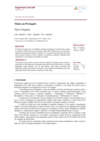Argamassas de cimento com incorporação direta de Materiais de Mudança de Fase
DOI:
https://doi.org/10.21814/ecum.4147Resumo
A eficiência energética dos edifícios é atualmente um dos principais objetivos da política energética a nível nacional e internacional. Os edifícios são um setor líder no consumo de energia, representando cerca de 40% do consumo de energia e emissões de CO2. A utilização de fontes de energia renováveis, tais como a energia solar, constitui um fator chave na redução da dependência energética dos edifícios. O armazenamento térmico conseguido através da utilização de materiais de mudança de fase (PCM) constitui uma estratégia para o desenvolvimento de edifícios com elevado desempenho térmico. Durante os últimos anos, vários estudos sobre materiais de construção com PCM encapsulado têm vindo a ser publicados. No entanto, a utilização de PCM não encapsulado é uma das principais lacunas do conhecimento. É importante notar que a utilização de PCM não encapsulado permite a utilização do material no seu estado puro, reduzindo os impactos ambientais e custo das soluções construtivas. O principal objetivo deste trabalho consistiu no estudo das propriedades físicas e mecânicas de argamassas com incorporação de PCM não-encapsulado, tendo sido possível concluir que a utilização de PCM nesta forma pode ser vista como uma solução económica e funcional para a melhoria da eficiência energética dos edifícios.
Referências
Ahmad, M., Bontemps, A., Sallée, H., Quenard, D. Thermal Testing and Numerical Simu-lation of a Prototype Cell Using Light Wallboards Coupling Vacuum Isolation Panels and Phase Change Material. Energy and Buildings 38, p. 673-681. 2006.
Alarcon-Ruiz, L., Platret, G., Massieu, E., Ehrlacher, A. The Use of Thermal Analysis in Assessing the Effect of Temperature on a Cement Paste. Cement and Concrete Research 35, p. 609-61. 2005.
Anjos, M., Camões, A., Jesus, C., Duarte, F. Avaliação da Hidratação de Pastas Cimentícias com Elevados Teores de Adições Minerais. Engenharia Civil UM 44, p. 41-58. 2012.
Athienitis, A. K., Liu, C., Hawes, D., Banu, D., Feldman, D. Investigation of the Thermal Performance of a Passive Solar Test-Room with Wall Latent Heat Storage. Building and Environment 32, p. 405-410. 1997.
Baert, G., Hoste, S., Schutter, G., Belie, N. Reactivity of Fly Ash in Cement Paste Studied by Means of Thermogravimetry and Isothermal Calorimetry. Journal of Thermal Analysis Calorimetry 94, p. 485-492. 2008.
Bhatty, J. I., Reid, K. J. Use of Thermal Analysis in the Hydration Studies of a Type 1 Portland Ce-Ment Produced from Mineral Tailings. Thermochimica Acta 91, p. 95-105. 1985.
Bilgen, S. Structure and Environmental Impact of Global Energy Consumption. Renewable and Sustainable Energy Reviews 38, p. 890–902. 2014.
Borreguero, A. M., Carmona, M., Sanchez, M. L., Valverde, J. L., Rodriguez, J. F. Improvement of the Thermal Behaviour of Gypsum Blocks by the Incorporation of Microcapsules Containing Pcms Obtained by Suspension Polymerization with an Optimal Core/Coating Mass Ratio. Applied Thermal Engineering 30, p. 1164–116. 2010.
Cabeza, L., Castell, A., Barreneche, C., Gracia, A., Fernández, A. Materials Used as PCM in Thermal Energy Storage in Buildings: A Review. Renewable and Sustainable Energy Reviews 15, p. 1675-1695. 2011.
Cunha, S., Aguiar, J. B., Ferreira, V. M., Tadeu, A. Mortars Based in Different Binders with Incorporation of Phase Change Materials: Physical and Mechanical Properties. European Journal of Environmental and Civil Engineering 19, p. 1216-1233. 2015b.
Cunha, S., Aguiar, J., Ferreira, V., Tadeu, A. Influence of Adding Encapsulated Phase Change Materials in Aerial Lime Based Mortars. Advanced Materials Research 687, p. 255-261. 2013.
Cunha, S., Aguiar, J., Ferreira, V., Tadeu, A. Influence of the Type of Phase Change Materials Microcapsules on the Properties of Lime-Gypsum Thermal Mortars. Advanced Engineering Materials 16, p. 433-441. 2014.
Cunha, S., Aguiar, J., Pacheco-Torgal, F. Effect of Temperature on Mortars with Incorporation of Phase Change Materials. Construction and Building Materials 98, p. 89-101. 2015a.
Cunha, S., Alves, V., Aguiar, J., Ferreira, V. Use of Phase Change Materials Microcapsules in Aerial Lime and Gypsum Mortars. Cement Wapno Beton Special Issue, p. 17-21. 2012.
Darkwa, K., O’Callaghan, P., Tetlow, D. Phase-Change Drywalls in a Passive-Solar Building. Applied Energy 83, p. 425-435. 2006.
Dollimore, D., Gupta, J., Lerdkanchanaporn, S., Nippani, S. A Thermal Analysis Study of Recycled Portland Cement Concrete (RPCC) Aggregates. Thermochimica Acta 357, p. 31-40. 2000.
Entrop, A.G., Brouwers, H.J.H., Reinders, A.H.M.E. Experimental Research on the Use of Micro-Encapsulated Phase Change Materials to Store Solar Energy in Concrete Floors and to Save Energy in Dutch Houses. Solar Energy 85, p. 1007–1020. 2011.
European Committee for Standardization (CEN). EN 1015-11. Methods of Test for Masonry - Part 11: Determination of Flexural and Compressive Strength of Hardened Mortar. 1999.
European Committee for Standardization (CEN), EN 1015-18. Methods of Test for Masonry - Part 18: Determination of Water Absorption Coefficient Due to Capillary Action of Hardened Mortar. 2002.
European Committee for Standardization (CEN). EN 1015-3. Methods of Test for Mortar for Masonry - Part 3: Determination of Consistence of Fresh Mortar (By Flow Table). 2004.
Fang, G., Tang, F., Cao, L. Preparation, Thermal Properties and Applications of Shape-Stabilized Thermal Energy Storage Materials. Renewable and Sustainable Energy Reviews 40, p. 237–259. 2014.
Hawes, D. W., Banu, D., Feldman, D. Latent Heat Storage in Concrete. Solar Energy Materials 19, p. 335–348. 1989.
Hawes, D.W., Feldman, D. Absorption of Phase Change Materials in Concrete. Solar Energy Materials and Solar Cells 27, p. 91-101. 1992.
Instituto Português da Qualidade (IPQ). NP EN 998-1. Especificações de Argamassas para Alvenarias – Parte 1: Argamassas para Rebocos Interiores E Exteriores. 2010.
Kaasinen, H. The Absorption of Phase Change Substances into Commonly Used Building Materials. Solar Energy Materials and Solar Cells 27, p. 173-179. 1992.
Laboratório Nacional de Engenharia Civil (LNEC). Especificação E 394. Betões – Determinação da Absorção de Água por Imersão. 1993.
Lai, C., Chen, R.H., Lin, C. Heat Transfer and Thermal Storage Behaviour of Gypsum Boards Incorpo-Rating Micro-Encapsulated PCM. Energy and Buildings 42, p. 1259–1266. 2010.
Memon, S. A. Phase Change Materials Integrated in Building Walls: A State of the Art Review. Renewable and Sustainable Energy Reviews 31, p. 870–906. 2014.
Principi, P., Fioretti, R. Thermal Analysis of the Application of PCM and Low Emissivity Coating in Hollow Bricks. Energy and Buildings 51, p. 131–142. 2012.
Rubitherm, RT22HC. Disponível em: <http://www.rubitherm.eu/en/index.php/productcategory/organische-pcm-r>. Acesso em: Dez. 2015.
Shilei, L., Neng, Z., Guohui, F. Impact of Phase Change Wall Room on Indoor Thermal Envi-ronment in winter. Energy and Buildings 38, p. 18-24. 2006.
Soares, N., Costa, J., Gaspar, A., Santos, P. Review of Passive PCM Latent Heat Thermal Energy Storage Systems Towards Buildings Energy Efficiency. Energy and Buildings 59, p. 82–103 2013.
Tyagi, V., Kaushik, S., Tyagi, S., Akiyama, T. Development of Phase Change Materials Based Microencapsulated Technology for Buildings: A Review. Renewable and Sustainable Energy Reviews 15, p. 1373-1391. 2011.
Zalba, B., Marín, J., Cabeza, L., Mehling, H. Review on Thermal Energy Storage with Phase Change: Materials, Heat Transfer Analysis and Applications. Applied Thermal Engineering 23, p. 251–283. 2003.
Zhang, Y., Zhou, G., Lin, K., Zhang, K., Di, H. Application of Latent Heat Thermal Energy Storage in Buildings: State-Of-The-Art and Outlook. Building and Environment 42, p. 2197–2209. 2007.
Downloads
Publicado
Como Citar
Edição
Secção
Licença

Este trabalho encontra-se publicado com a Licença Internacional Creative Commons Atribuição 4.0.








